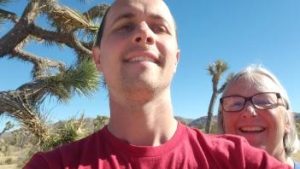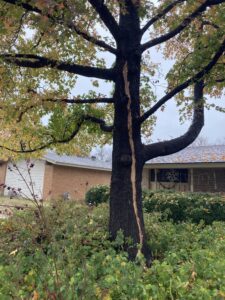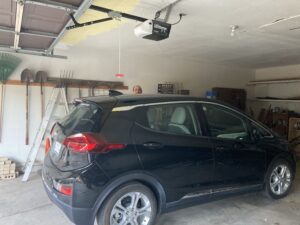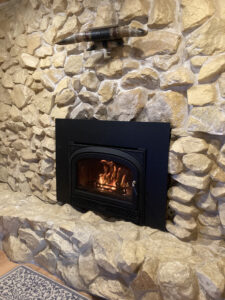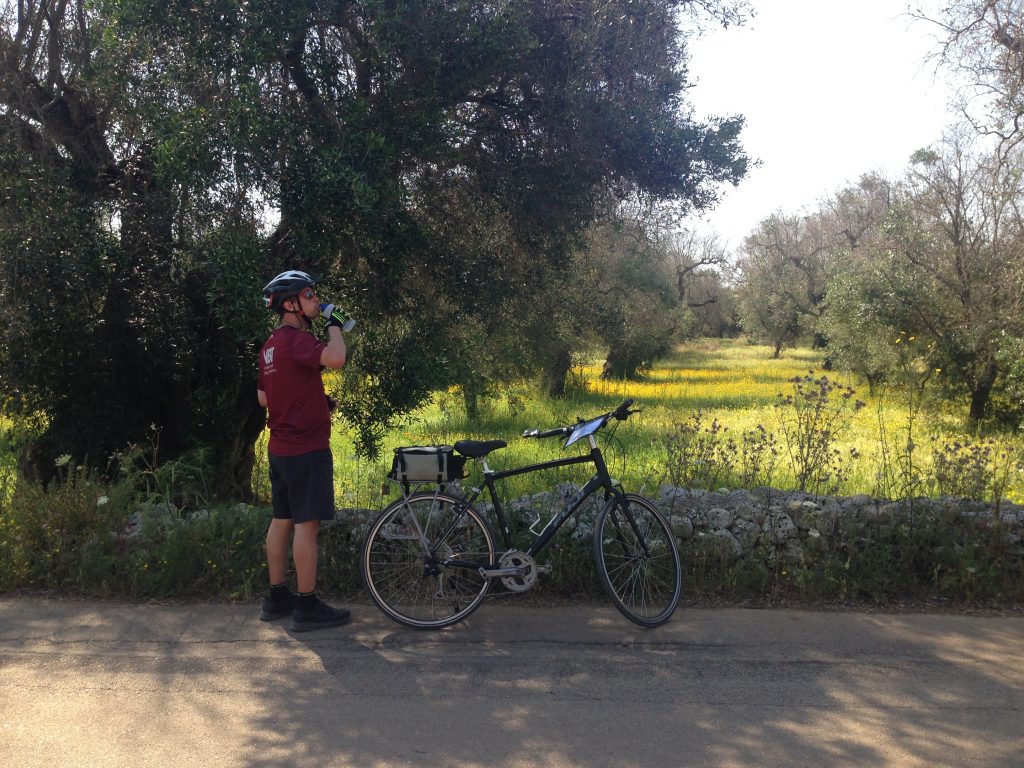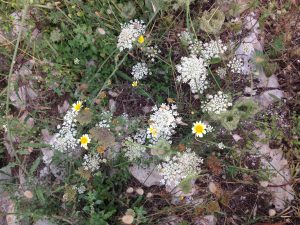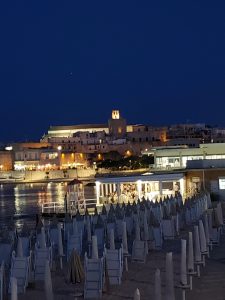decision-making
A lot of slop and wobble
The words about to unfold below weren’t exactly how I planned to start or end this post. The house is quiet and Sam is likely napping. We just finished a Sunday bike ride down the rail trail, which felt a little like a victory lap today. On Monday, we rode the trail all the way to Lewisville Lake so we could get a good, long time with totality.
(That supposed life hack of holding solar glasses to your smartphone to shoot the eclipse? I stopped trying to take photos after this shot. I cherish the images in my memory. It was an unparalleled life experience–babies being born, totality, etc., etc.)
Today’s victory lap was marred by a motorist who chose the moment he passed us (we were waiting at the McKinney Street crosswalk by City Hall) to lay on his horn a good long time. A few motorists have done that to us in the past. Each time, as the adrenaline shoots through you, it feels a bit like someone punched you in the face.
Whether honking a horn like that should be considered assault may feel like an open question. Yet Sam’s reaction today, as in the past, convinces me that it is. He’s a beast of a cyclist, but after the horn, he took off like a cheetah. He was already through Quakertown Park and halfway down Congress Avenue by the time I got to the little bridge over Pecan Creek.
For the rest of the ride home, he’d pedal at incredible speeds and have to circle back to meet me before taking off again. I can’t imagine how much adrenaline is coursing through a person’s body that it takes more than two miles of fast pedaling to work it off. During one circle back, he said to me, “I’m a good person. But it doesn’t matter to him. That’s why I can’t feel safe.”
Risk is always with us. It’s hard to calculate sometimes. I borrowed today’s headline from a Washington Post story about calculating Earth’s rotation. I never doubted the math for the eclipse, which takes into account the slop and wobble of our little orbit around the sun. It was marvelous to sit on the lakeshore Monday, looking up through solar glasses to watch the eclipse start and progress and make the world go dark, just like they calculated.
A lot of modern life takes all this elegant math for granted. We need to remember that the world may speak in calculus, but life is not precise. What makes some math so elegant is that it hasn’t forgotten about all of life’s beautiful slop and wobble.
I suppose we could stop riding bike, but that’s no way to address the risk. Or we could insist that police ticket motorists for assault when they use their horns that way, but that introduces other risks.
Or, maybe I could write an essay about life’s slop and wobble, sending a little message out into the world that asks everyone to please be kind to all cyclists, because you don’t know which ones might be autistic.
Road trip
It took some time to notice, but both Sam and I agree the pandemic made our lives a little smaller.
Don’t get me wrong. There were things we did, things we neglected, routines we filled, habits we clung to, all that needed to change. And we stopped being busy for busy’s sake (what was that about?)
But ‘opting out’ also sets its own traps. A certain brittleness can settle in. We needed to stretch.
We’ve gone on cycling trips to help with that. Acadia National Park in 2021. Lake Champlain in 2022. But this year, we felt like we needed to nudge in another direction. After we were invited to a wedding in Phoenix, I got out the maps and started studying road trips. After all, Phoenix is just a few hours from California. As a good friend says, it’s just “map math.”
But I wasn’t planning a grand tour. This trip could reconnect us to our family’s origin story. Sam and his brother and sister were all born in Sacramento. Their father was principal tuba of the Sacramento Symphony until it went bankrupt. We lived there until Sam was 5 years old.
A road trip could help Sam see that he was a Californian and still belonged, if he wanted that option. We took the kids to California several times on summer trips. Sam went back to visit once on his own (his godparents live in Stockton) when he was in his 20s. But visiting a place for fun is different than visiting with an eye toward making a life there.
Many of us don’t always feel we have options and sometimes this seems more so for Sam. We planned this trip to explore his options,. The company he works for has a similar facility in Modesto. Touring the Modesto location could help him think about his future in new ways.
We had all the fun we could stay awake for in Phoenix, and headed out the next day. We took a nice, leisurely detour through Joshua Tree National Park (amazing!) and spent the night nearby.
Then the next day we headed to Modesto, stopping in Fresno. I suggested a stop at an underground garden. I thought it would be a world’s-largest-ball-of-twine-roadside-attraction type of stop, but it turned out to be a national landmark and completely charming.
The next day, we toured the Modesto facility and wouldn’t you know, Sam already knew some of the people working there. They didn’t have any openings right then, but that’s not how Sam thinks things through anyways.
In the month since, though, I’ve heard him say many, many times, “I have options now, Mom.”
Never, ever underestimate the power of a road trip.
Keep learning
It’s New Year’s resolution time!
For the past five years, I’ve tried to make resolutions that are more meaningful. Whether it was saying “no” to buying things or “yes” to new challenges, or remembering that a solution already exists, those kind of resolutions brought more options and opportunities with them.
This year, for some reason, I had a hard time finding a new and meaningful pledge. To help, I read one story that suggested using a motivational word, like “breathe” or “focus” or “gratitude.” I liked the spirit of that suggestion, but wondered if a single word mantra could fall short of being meaningful.
Then, a couple things happened.
First, lightning struck a tree out front.
We were home when it happened, but we were in the back. We thought the lightning had struck a nearby transformer. We didn’t see the ball of fire that our neighbor did.
Still, we’d noticed that we’d lost our internet connection and the stereo was off. After our neighbor knocked on the front door, we saw the tree. At that point, we realized that we had a rolling disaster on our hands.
Sam spent hours troubleshooting. We brainstormed until we isolated all the things we had to fix, developed a working theory of what happened so we knew what else might be at risk, and decided what electric items were probably ok.
Based on the damage to the internet routers, we were a little scared until we could rule out a slow burn in the attic. We were grateful that–thanks to last year’s resolution to be prepared and resilient–most electrics had surge protection and had survived the strike, as did the surge protectors themselves.
Second, we took Sam’s Chevy Bolt on a long trip for the first time last weekend, from Denton to Austin and back. This was the first time to feel what EV owners call “range anxiety.” We discovered that the car’s information system was perfectly capable of predicting how many miles were left on the batteries. But we did worry whether the charging stations, which are few and far between, would be available and operational.
The trip went fine. The charging cost less than $8 on the way down, and was free on the way back. We had lunch during one charge and the fellow at the deli counter had SO many questions. Clearly, he was wondering whether driving an EV was an option for him. We answered all that we could but we were still learning, too, to which the deli guy summed, with so much wisdom, “It’s new.”
That’s was kind of an “aha” moment. We can’t always choose the moments that the world wants to teach something, and it does little good to close the door to those learning opportunities. I get grumpy solving problems that I’ve solved before; life is hard enough as it is. I don’t want to think about how appliances work. Yet, there was real power in learning how everything in our house worked. Driving to Austin is hard. Why make it harder by driving an EV? Yet, the car was quiet and a dream to drive. The charging breaks made the trip longer, but far less exhausting.
Hey, 2023. We will keep learning wherever the opportunity knocks.
See Sam Drive, EV edition
We had to get up early today to meet the man delivering Sam’s new car. He bought a 2018 Chevy Bolt from the Fort Collins, Colo., dealer where my brother-in-law works. Sam was so very patient. When his uncle mentioned they had two Bolts on the lot waiting for their recall work, Sam put $500 down. That was back in December 2021.
Sam has been driving a 2001 Toyota Corolla since he first learned to drive 15 years ago. He also bought that car from his Uncle Matt. We started talking about replacing the Corolla around 2018-19, but Sam moves slowly with these kinds of decisions. He went to the auto show at the State Fair with his brother and sat in a Chevy Bolt. He tentatively decided he would replace his car in 2020. Then the pandemic came and life slowed down so much. It bought him a lot more time to shop for a car, which was good, because Chevy needed time, too, to make those battery repairs.
He didn’t need much coaching through all of this, at least not from me. Matt may have had to work a little harder to make the sale and delivery, I certainly can’t speak for him. The only thing I really weighed in on was getting the car back to Texas. We talked about flying up to get the car and driving back, but once we crunched the numbers, shipping won out. He agreed to do it, since it was cheaper by about a factor of 10.
He still has a bit of a to-do list — insurance, Texas plates, toll tag, etc. I did write that up and put it on the fridge for him, so I suppose that’s coaching. And he’s going to reach out to other EV drivers for wisdom, since this car is several generations more sophisticated than either of the vehicles we currently drive.
Life really is so flipping complicated. I have little idea how I got through things the first time myself, although I do remember a habit in my 20s of calling my parents often and asking adulting questions. I do also prompt my other kids–probably more than they would like–with the preface of ‘let me tell you something I learned the hard way and save you some time/money/heartache.”
Have you ever thought about all the problems you solved in your 20s?
Prepared. Resilient.
I had forgotten how wonderful a warm fire feels on a cold day. We had a wood stove at the farm. After we moved to town, installing a wood-burning fireplace insert went on the to-do list, but it would always slip down a few notches as other things crept up the list.
I grew up in Wisconsin. I have never been so cold in my life. We saw the forecast, so we prepared. We filled three five-gallon jugs and the bathtubs with water. We had two weeks’ worth of food (although my plans to make lasagna mid-week were foiled). I also made a point of finishing the laundry on Sunday night.
Back in 2011 the power outage didn’t last as long, but we didn’t suffer because the wood stove kept us warm and heated coffee (always essential) and food. Here in town we have a gas furnace, but every time the electricity rolled off during Uri, so did the heat. Getting a wood stove went to the top of the to-do list.
As the good people at Heffley’s installed the fireplace insert this fall, I learned how lucky we were that we didn’t chance using the old gas logs. (Before we moved in, the home inspector declined to check the fireplace. He told me to get a plumber instead. That job never even made the to-do list.) We discovered that the rock façade had separated from the chimney. We probably would have set the house on fire that week.
The whole experience made me re-think what it means to be prepared and resilient. We took care of some of that this year. But buying stuff (we also got a Goal Zero battery with solar panels and a portable cooktop) doesn’t necessarily make you prepared and resilient.
Perhaps the last five years’ of resolutions were leading to this moment — saying no to buying stuff, saying yes to new experiences, better connecting to others, wearing an apron (looking for simple solutions), and taking it (whatever it might be) to all four corners.
Sometimes I think about those worst-case scenario books the kids loved when they were young. They were often funny and terribly fantastical (dodging an alligator attack or elephant stampede, landing a jet, etc.) but after Hurricane Harvey, I wondered how to pitch the tent on the roof. In the meantime, we will set up our go-bags.
Climate change is here. Time to be prepared and resilient.
Reagan was wrong. There is no trust when you must verify.
The first time I took Sam to school and left him for a full day was a big leap of faith. I wasn’t alone, of course. Parents want to protect their kids. And parenting a child with autism or other disability puts that protective feeling into overdrive. Eventually I saw that we weren’t alone. His many teachers and therapists were part of his village. Later that year, I walked into a special education team meeting and recognized that, for the first time in Sam’s young life, I was not “on call” for every minute of every day. It was such a nice feeling, one that left room for more thinking and reflecting about our lives, and for resting, too.
That’s not to say that his school years were perfect. We knew not everyone in his life would be as mindful. But we also knew that the perfect is the enemy of the good. When conditions warranted, someone at school picked up the phone and told us about an emerging problem. We addressed many small things before they got big. And we learned to celebrate the average and the good enough, which was its own kind of achievement for Mark and me.
So (and you knew there was a so, didn’t you, dear internet people?), I struggle deeply with the burgeoning installment of security cameras at school. We aren’t just pointing cameras at the school’s exterior doors. Or in the hallways. Or from the school resource officer’s body armor. We are pointing them inside the classrooms, too.
In Texas, parents can ask for a camera in their child’s special education classroom. The school must get consent from parents of the other kids in the class, but such camera use is on the rise. Advocates for kids with disabilities continue to press the legislature for broadening a family’s rights to footage. One day, some parent will send their child with a disability to school with a body camera if they believe it’s necessary.
I recognize that school can be a rough place for children who don’t fit in for one arbitrary reason or another. Sam was getting hassled in the boys’ bathroom one year, and solving the problem proved tricky for the aides, both women. But we figured it out.
I recognize also that some schools are hard pressed to fill their teaching ranks. There are employees without enough skills to work with and manage kids, the place where most tragedies begin.
This is not to say that people in our community might have different values from my family’s or yours. As a culture, we wobble too much in figuring out how to work with those differences as strengths and educate our children. But I have to say, where parents are asking for cameras, we aren’t reading those huge warning flags.
When Sam graduated high school, I wanted everyone from elementary school on up to have a “Team Sam” button as a little token of our esteem and affection. I ordered 250 buttons and did not come close to gifting all those people who touched his life and helped him make progress. Dozens of teachers, of course, but also speech therapists who worked with him on communication skills. Occupational therapists and adaptive physical education teachers who helped him with his motor planning and ability to calm himself. School counselors who helped him build friendships. Aides who helped him stay on task in class and occasionally take a moment to decompress when he couldn’t. And the principals and other staff who stood by and made sure all those people had the support they needed.
I had to trust these people. All of them. A lot.
There was no “trust but verify.” Where there are cameras, there is no trust.
Conservative guardianship
Britney Spears’s battle to be free of the conservatorship that has governed her affairs touches familiar themes for us old-timers in the disability world. She’s asking for the grown-up version of the least-restrictive environment, the federal right of children with disabilities to receive a free, public education alongside their peers in regular education classes, with support, if necessary.
For now, the least-restrictive environment is the best way we know to ensure every child has access to all they need to learn and grow into their best selves.
Over the years, I’ve seen a few families struggle to understand what guardianship really means. Adults need a least-restrictive environment, too. When Sam approached high school graduation, we were told that, as his parents, that we’d better think about setting up guardianship before he turned 18. It has been a few years now, and perhaps understanding has improved among the teams that do this transition planning, but at the time, Mark and I really thought that recommendation came out of left field. We’d fought for Sam his whole life for him to be included at school and in the community, to be in that least restrictive environment. Something about guardianship felt very restrictive to us.
Then an older, wiser friend boiled it down for us. “You’ll have to tell a judge, in front of Sam, that he’s incompetent.” I can still see Mark’s face when he realized what that meant. “We could never do that to Sam,” he’d said. To which I’d replied, “oh, hell no, we couldn’t.”
I often bring the salt, just FYI.
For our family, that ended the guardianship discussion right there. I did poke around a little, however, to figure out ways we could be his bumper guard. Once you start looking around, there are all kinds of ways to be there for someone, even in a somewhat official capacity, from bank signatories to putting both names on a vehicle title to advance directives and more–all without ever stepping foot in a probate court.
Last week, I learned even more about the power of supported decision making, an alternative to guardianship that gets you in the door when your loved one really needs you. These documents are legally recognized, even if your loved one is ensnared in the criminal justice system. One-page profiles can also help a lot for those times you can’t get in the door–when your loved one is in the hospital with covid, for example.
When your loved one truly needs a guardian, it pays to be thoughtful and as minimally restrictive as possible. That can be tough in Texas, just another FYI.
This year, advocates helped defeat a troubling bill filed in the Texas House of Representatives during the last regular session. If it had passed, the bill made it too easy for parents to get and retain guardianship of their teen. The legislation was inspired by one family’s tragedy, but it was rife with unintended consequences that would have stripped many young adults of their autonomy—especially if special education transition teams in Texas school districts are still advising parents to pursue guardianship without thinking it through.
Community of practice
I finally moved my personal things out of my old office space, thanks to the help of a co-worker who also had to listen to me prattle on about things like how many piano makers there were before and after the Great Depression and why that might mean something to journalism now.
I have a century-old, upright grand piano. My parents got it for me when I was first learning to play. It has a big sound, especially after I had it rebuilt about ten years ago. The man who rebuilt it told me that before the Great Depression there were more than 400 piano makers in the United States. After the Great Depression, there were just two.
That seemed a stunning loss to me. Many people love music and enjoy playing, even if just for themselves. Pianos are among a handful of instruments that play both melody and harmony. However, our attention is never guaranteed, and our money usually follows wherever our attention goes.
That same drifting attention is happening to the news business now. Businesses needed your attention, so they got it by putting their advertisements next to news. Newspapers were among the original public-private partnerships. The better quality the news — a real public service at that point — the more valuable that space got. That is, until our attention started to drift.
One of the Denton newspaper’s most popular reports was the police blotter, at least before the pandemic began. It had long been a guilty pleasure for readers. Of course, now they can find even more guilty reading pleasures on Facebook, a company only too happy to hoover up the advertising revenue as people’s attention drifts over there. Probably in another year or two, there will be only a handful of news outlets left because the business model that extracted value out of our attention has changed so much.
Some people have finally figured that out, that the business model now is for people who recognize they need solid journalism to make sound business decisions and to make good public policy decisions.
Without that, we will soon have warlords squabbling for years while ticking time bombs sit in our harbors.
I’m ready to stop thinking about the business model and start thinking about the community of practice — journalists are a group of people concerned about the quality of information, how it’s gathered and vetted, and how to do it better, and the best way to do that is by debating all those values regularly among your peers — and then publishing or broadcasting.
This community of practice in journalism is also the same thing that people like to criticize as “the priesthood” or the “legacy elite” or “media bubble” or whatever other pejorative they want to hurl at the wall that might stick for the moment. But humans create communities of practice because they care about what they do and want to do it better, and scholars are beginning to recognize how much this phenomenon has helped all kinds of businesses do better and make progress in our modern world.
My first introduction to communities of practice came in the autism world, with parents sharing wisdom and such. Eventually, parents started seeing that the best therapists with the most powerful ideas kind of hung out together and fed off each other’s practice and research. No one was talking to you about a “community of practice,” but if you wanted the best for your child, you always wanted to be close to that, since chances were higher that your kid would benefit from all that supercharged brainpower and skill.
I encouraged Michael and Paige to find the equivalent as they ventured out into the working world, although I didn’t have the vocabulary for it at the time. At the University of Iowa, they organized the dorm into micro-communities that way and Paige fell right in. She’s still friends with many of her original writing community. Michael got a power introduction to the concept as a behavior tech in the autism world. He’s like a heat-seeking missile for that value where he works.
Journalists sometimes compete with each other, but we benefit from each other’s successes and critical takes on each other’s work. The successful business model(s) will depend on the rigor within our community of practice. As business models disappear and fail, that doesn’t mean the community of practice must also, but it makes it a lot harder. Until the emerging business models stabilize, our environment is ripe for propaganda disguised as news. But if our community of practice disappears, no business model will save it.
Just like the piano makers.
Leap and the net will appear
Early in my career, a fellow writer and sometimes mentor said that he didn’t always know what he thought until he started writing.
That was a freeing thing to hear. The fear of the blank screen vanished. I didn’t have to know exactly what I was writing before I started. I could discover what I was thinking along the way. I could re-write again and again to make it clearer, fixing any flabby thinking and respecting the reader, because what is writing if no one reads it?
We all read to better understand what others are thinking and to adjust our thinking accordingly, writers most especially included.
Which brings me to this morning’s topic, writing to better understand a hella lotta thinking that happened this week, because this week, I quit my job.
Until Tuesday night, I had a good job that has become increasingly rare — a full-time journalist for a family-owned newspaper. The job didn’t pay particularly well, but I enjoyed the work and I was fairly good at it, so it had its own reinforcement loop that didn’t have a lot to do with money (does it ever for a writer?). I felt I was serving the community I love. I’m sure some people thought it was unnecessarily tough love at times, but I hope we can just agree to disagree there. Sorry, Charlies, sometimes the truth is really tough.
So as I climbed the hill that my job was about to die on, I was surprised at my courage to keep going. Then I saw that my feet held because they kept finding the truth. I may not have uncovered everything there was to know, but what I did know to be the truth was this: who and what was important to me might die (not exaggerating) if I didn’t keep going to the logical finish.
It’s not the first time in my life that I leapt knowing in my heart that the net would appear.
To sum up the thought for the day, I grabbed a few of my favorite lines from my upcoming book with co-author Shahla Ala’i (which luxuriously now has my full attention, a good thing because we have to deliver to the publisher in about six weeks), Love and Science in the Treatment of Autism:
Love may be the only thing that is not fragile in our material world. Love makes a great bet. Love gives our lives meaning. With love, we forge through troubles and make progress. Love makes a family. We know we will fail sometimes and that love grows in learning from those failures. Love helps us through periods of being unlovable ourselves, or of not loving others.
We keep choosing love, above all.
Cycling close to the sun
Sam said he liked the country roads best on our family bicycling trip to southern Italy. There are 60 million olive trees in Italy and I do believe we pedaled past a hefty percentage of them.
In this photo, you can see he stopped next to an olive tree that was a thousand years old. Some of them look great. Others are succumbing to a bacteria that came over with an insect stowed away on South American-made pallets. Many of the olive groves are small, family-owned plots that produce enough to supply the family with a little more to share. (You can buy olive oil in Italy the way we buy craft beer here in the U.S.)
On the backroads, you can trade that ten-European-cities-in-seven-days experience for a different kind of intensity. What’s not to like when you share miles of road lined by stone walls with just the occasional tractor or Italian nonno driving his 1967 Renault Quattro to the village? The roads weren’t perfect, but Sam didn’t mind dodging the potholes. Once, along a highway, I watched him drift, ever so slightly, into the main lane so that he could cycle over the rumble strips.
On the backroads, you can catch the fragrance as you pedal by chamomile, star jasmine, ginesta (broom) or the pine trees.
You can see a farmer having a sandwich in the shade of an olive tree. Another farmer stops picking to pass a handful of fresh figs over the wall to a fellow cyclist. Old men sit on benches in the center of the village and wish you “buongiorno!” The village center doesn’t look like it’s changed much at all in several hundred years.
Sam was ready for the routine, having gone on a similar tour last fall in Germany, Austria and Switzerland. We pedaled a good pace and still found time to relax in the swimming pool after covering 20-30 miles each day. Nobody lost anything along the way. The only real drama came the last day. A driver honked and then turned right in front of Paige, thinking that Paige would stop (uh, NOT) and then nearly hitting her on her bike. One of the tour leaders detoured to yell at the driver. The moment was so quintessentially Italian that I couldn’t help but live vicariously through the movie she was making for me right then and there.
Sam downloaded two dictionaries before we left the U.S. and explored the language often. He always tried to order in Italian. Periodically, he also thought of things that would increase our comfort and success in living out of a suitcase for days at a time. He inspired me to start a new checklist for our next trip — when or wherever that might be. At one point, he told me he thought he could take the next tour by himself.
He probably could, but that was never a goal of these trips. Traveling brings new perspectives. We bring some of the romance home by letting the experience change the shape of our daily lives. Sam grows through travel just like the rest of us, only a little bit more. He has always cycled a little closer to the sun.

